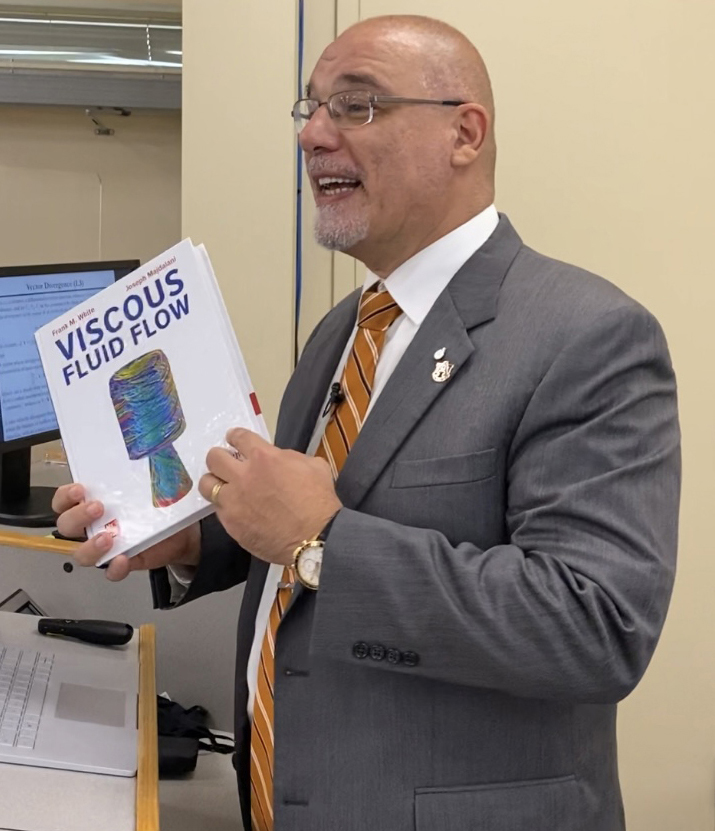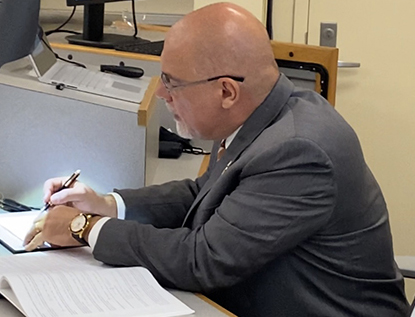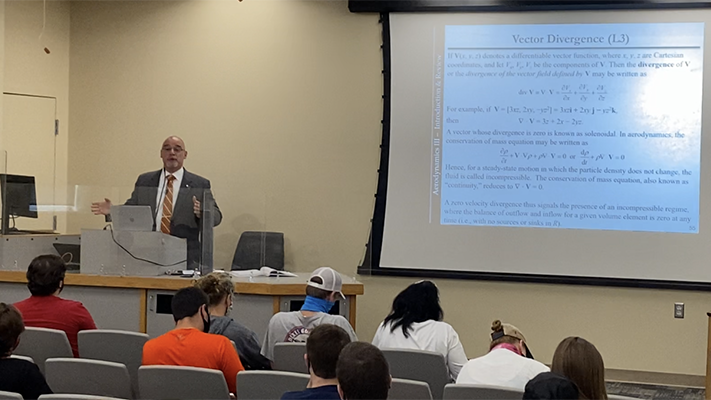Professor in aerospace engineering launches fourth edition of classic textbook "Viscous Fluid Flow"
Published: Aug 25, 2021 9:15 AM
By Joe McAdory
Joseph Majdalani considers “Viscous Fluid Flow” to be the one-stop-shop textbook that guided his academic career.
“It’s my bible of engineering textbooks,” said Majdalani, professor and Hugh and Loeda Francis Chair of Excellence in aerospace engineering at the Samuel Ginn College of Engineering. “I absolutely love this book. Of all the textbooks that I have used, the one that I’ve referred to the most has been this book.”
Whereas “Viscous Fluid Flow” previously guided his career in aerodynamics and propulsion, Majdalani was given the opportunity to revise the textbook’s fourth edition – serving as co-author with original best-selling author Frank White.

“It’s really an incredible honor to be a part of this encyclopedic textbook because I’ve learned so much from it over the years,” said Majdalani.
Majdalani joined Auburn in 2013 and is recognized for his seminal work on acoustic instability theories and vortex engine technologies spanning solid, liquid and hybrid rocket applications. “It’s a dream come true to be part of this project,” he said. “Plus, Dr. White means the world to me. He has inspired hundreds of faculty members and fluid dynamicists from around the world.”
"I am very excited that new generations of engineers will be able to continue to learn this material, using this wonderful new edition,” White said. “I am truly appreciative of the terrific work my colleague Joe Majdalani did to revise the book, and am particularly delighted by the breakthrough on the Pohlhausen Paradox."
“Viscous Fluid Flow” teaches students the basic foundations of advanced fluid mechanics. It is vital to a variety of engineering disciplines, including the fields of aerospace, mechanical, ocean, chemical, civil, biomedical, industrial, and biosystems.

Majdalani said when he was first contacted by the publisher, he provided a plethora of valuable recommendations. “I provided the publisher with about two hours’ worth of suggestions,” Majdalani said. “Because I had been using this book, I knew precisely where the gaps were and how to overcome them.”
Besides unifying the nomenclature and consistency of equations, he proposed adding student-friendly appendices and supplementary material to make the book more usable. He created self-guided exercise problems that were conceptual and three-dimensional.
“The textbook took more than three years in the making, literally every free minute that I could spare,” Majdalani said. “I had to review and incorporate hundreds of references. I revised thousands of equations. It was such an endeavor to build this from the ground up and pretty much repolish the entire textbook.”
Majdalani said the revised textbook introduces new modern concepts and provides students with a better understanding of fluid dynamics and thermal science; it better prepares them to succeed professionally in the fields of energy, aerospace, propulsion, aerodynamics, thermofluids and chemical transport.
“Students who take this course will develop a mastery of the underlying fluid mechanics and thermal sciences principles and the ability to solve – quickly and efficiently – a variety of real fluid mechanics and heat transfer problems,” Majdalani said. “The problems and tutorials help the students gain deeper physical insight and to develop, by practice and trial, the mindset of an effective problem-solver in fluid dynamics and aerodynamics."
“This is also a great opportunity for Auburn University to increase its global footprint through this impactful publication used by thousands of universities worldwide,” Majdalani added.
Published by McGraw-Hill among its classic series, “Viscous Fluid Flow” fourth edition is available this fall to be used in classrooms across the globe.
According to Roy Hartfield, Walt and Virginia Woltosz professor and assistant chair of aerospace engineering, “Viscous Fluid Flow is arguably the most significant publication in the history of our department.”
Regarding its impact on education, Hartfield added, “The book is published by McGraw-Hill, translated into foreign languages, and widely regarded as the premier reference on the subject. Dr. Majdalani compiled an extensive body of work, including refresher problems, pedagogical sections, new appendices, slide presentations, and a new solution manual. Dr. Majdalani identified strengths and weaknesses in the text and rewrote many of the unclear sections while directly incorporating student feedback."
“This highly interactive rethinking of the way we improve learning resulted in profoundly novel treatments of the material and even a series of impressively new discoveries pertaining to the general solution of the boundary layer equations,” Hartfield added. “One such solution was constructed famously by Pohlhausen in 1921. This solution has stood for nearly a century as the accepted analytic solution to Kármán’s boundary layer problem, albeit with nagging caveats. Dr. Majdalani discovered a much more accurate solution and procedure to solve boundary-layer problems. Ultimately, Dr. White referred to Dr. Majdalani’s discovery of a clear explanation of the Pohlhausen paradox and his simple solution of the celebrated Blasius equation among the most important discoveries in boundary-layer theory since 1921. His work with his late postdoctoral student, Dr. Lijun Xuan, was accepted within four days and designated as a feature article on the cover of the Physics of Fluids.”
Aside from his work at Auburn University, Majdalani is a fellow at the American Society of Mechanical Engineers, associate fellow of the American Institute of Aeronautics and Astronautics (AIAA), editorial board member of the Physics of Fluids, and author of more than 300 publications in physics, mathematics, aerodynamics, and propulsion.


Professor Majdalani's Viscous Aerodynamics class (Aerodynamics III) is the first at Auburn University to use the "Viscous Fluid Flow" fourth edition.


